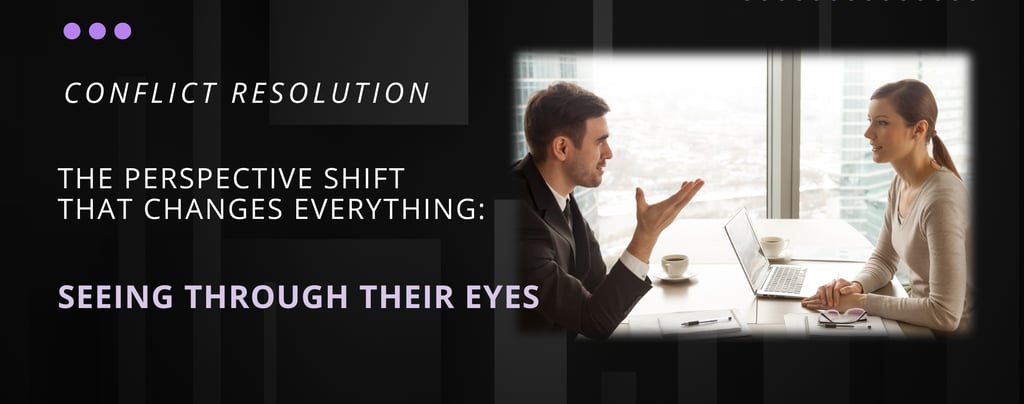The Perspective Shift That Changes Everything: Seeing Through Their Eyes in Conflict
Understanding another person’s perspective is the key that transforms conflict into connection—whether between individuals or across a team. This post explores how asking thoughtful questions (instead of making assumptions) can shift the energy, rebuild trust, and open the door to real resolution.
7/24/20252 min read


Conflict is inevitable. But escalation? That’s optional.
Whether in one-on-one disagreements or team-wide tensions, the most underrated yet transformative skill in conflict resolution is perspective-taking—the ability to step into someone else’s world and see through their eyes, even when you don't agree.
Most of us want to feel seen, heard, and understood. So when conflict arises, we become so intensely focused on expressing our own position—on being right—that we stop doing the very thing required to actually analyze the problem and find a real solution. And that begins with understanding where the other person is coming from.
That’s where the shift begins.
Ask, Don’t Assume
And that shift isn’t about mind-reading—it’s about asking. Not with a tone of accusation, but with curiosity:
Can you help me understand how you see this?
What’s most important to you right now?
What would a good outcome look like for you?
Too often, we assume we know what’s driving the other person. But assumptions are shortcuts. In conflict, they usually lead us further from resolution and deeper into miscommunication. We oversimplify. We react to a story in our head instead of the real human in front of us.
Genuine questions open a window. They give the other person a moment to exhale—and give you both a chance to connect beyond the surface.
The Team Advantage: When Everyone Feels Understood
In teams, conflict doesn’t just affect two people. It ripples. Misunderstandings fester. Silence replaces synergy. But when leaders foster a culture where listening and curiosity are valued over defensiveness, teams transform. Differing viewpoints become data, not threats. A disagreement becomes a chance to innovate, not implode.
It’s not about agreeing with every perspective. It’s about acknowledging it.
When people feel heard, they let go of their grip. They’re more likely to soften their stance, explore compromise, and collaborate toward solutions.
The Real Power of Perspective
Understanding someone else’s perspective doesn’t mean giving up your own. It means having the strength and self-awareness to hold both. That’s the hallmark of effective leadership, partnership, and maturity—being able to say:
“I see where you’re coming from, even if I see it differently.”
In that simple sentence lies the power to de-escalate conflict, rebuild trust, and co-create something better.
In Practice: Three Grounding Questions to Use in Conflict
Some questions are meant to be asked out loud—to build understanding and open communication. Others are meant to be asked internally—to challenge your own assumptions and regulate your response.
Here are three to use in the moment:
What matters most to them right now? (Better: ask them directly.)
How might they be interpreting my words or actions? (Better: clarify with them.)
What story might I be telling myself—and how true is it? (Pause, then fact-check it.)
Try these in your next difficult interaction and notice what shifts when you move from certainty to curiosity.
Final Thought
Conflict isn't the enemy—disconnection is. And perspective-taking is how we reconnect. Not just with others, but with our own higher selves—the part of us that seeks understanding over victory, and unity over ego.
When we learn to see through their eyes, we don’t lose ourselves.
We lead.
SYNERGYLM, LLC
liz.michael@synergylm.net
7901 4th St. N #25825
St. Petersburg, FL 33702
© 2025. All rights reserved.


